In Addition
Vol 15 Ausgabe 1
January / February 2024
1. Health Tips
Take wholesome foods rich in Vitamins – essential micronutrient for health!
“If vegetarian food consumed is balanced and wholesome, it should contain liberal doses of vitamin C and vitamin E, which are available in vegetables like carrots. Every effort should be made to keep the human body healthy. Health is wealth. Wealth cannot be enjoyed by a person with poor health. Health is more important because it gives physical and mental strength to a person.”…Sathya Sai Baba1
In the previous issue of our newsletter, we dealt with macronutrients (macros) for a balanced diet. This article will delve into an essential micronutrient, the vitamins.
1. Importance of Vitamins
1.1 Vital for health: Vitamins and minerals are two vital nutrients that a body needs in small amounts to survive and stay healthy. They are collectively known as micronutrients (micros); they metabolise the 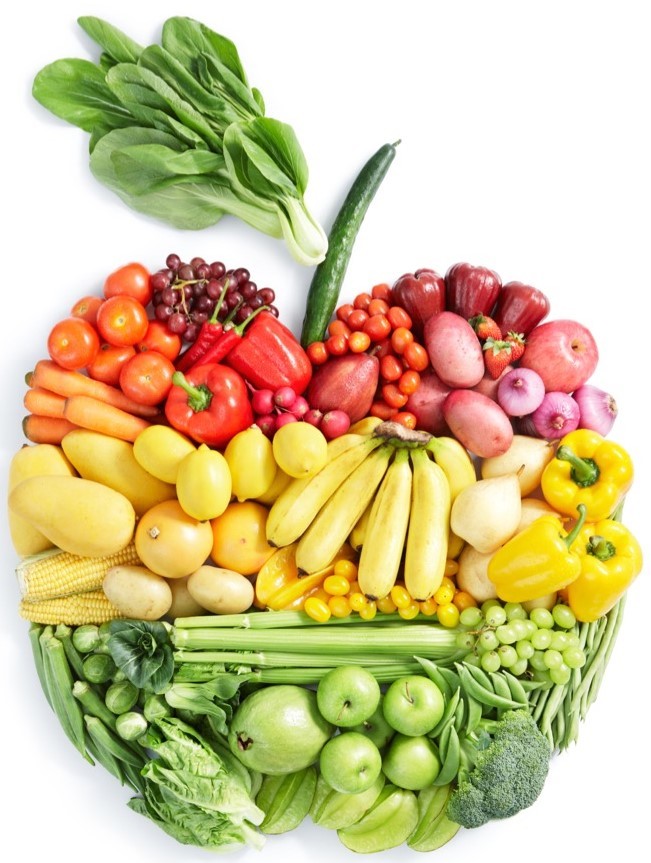 macros and enable us to get energy. The micros are so crucial that a deficiency can reduce energy level, mental clarity, and overall capacity, which may not be really noticeable but make us vulnerable to disease; later it can lead to severe health conditions, even life-threatening.2
macros and enable us to get energy. The micros are so crucial that a deficiency can reduce energy level, mental clarity, and overall capacity, which may not be really noticeable but make us vulnerable to disease; later it can lead to severe health conditions, even life-threatening.2
1.2 Precious role and variety: Vitamins are organic substances made by plants and animals, and are obtained from food for sustenance. They contain the element carbon that enables life on earth and plays a role in the function of every organ. The discovery of vitamins occurred  by 1948 after years of research and it became known that certain diseases can be caused by vitamin deficiency and not by infections and toxins. Broadly, there are 13 vitamins - A, C, D, E, K, and eight B-complex vitamins B1 (thiamine), B2 (riboflavin), B3 (niacin), B5 (pantothenic acid), B6 (pyridoxine), B7 (biotin, also called vitamin H), B9 (folic acid), and B12 (cobalamin). The missing numbers B4, B8, B10, & B11 are no longer considered as vitamins. All of them are needed by the body, though in varying amounts, dependent on its genetics and biochemical individuality.3-6
by 1948 after years of research and it became known that certain diseases can be caused by vitamin deficiency and not by infections and toxins. Broadly, there are 13 vitamins - A, C, D, E, K, and eight B-complex vitamins B1 (thiamine), B2 (riboflavin), B3 (niacin), B5 (pantothenic acid), B6 (pyridoxine), B7 (biotin, also called vitamin H), B9 (folic acid), and B12 (cobalamin). The missing numbers B4, B8, B10, & B11 are no longer considered as vitamins. All of them are needed by the body, though in varying amounts, dependent on its genetics and biochemical individuality.3-6
1.3 Nature of vitamins & usage: Vitamins A, E, D, & K are fat soluble and require sufficient amount of minerals and healthy fats in diet for better absorption and are stored in the liver and fat tissue; we don’t need to take them every day. Vitamin C and the B-vitamins are water soluble, stored for a short duration in the body. They have to be replenished frequently, except B-12 which is stored mainly in the liver for 3 to 5 years; any excess is normally excreted in the urine.7,8
2. Fat-soluble vitamins
2.1 Vitamin A is vital for the eyes, skin, and immune system to fight disease and infections. It also keeps the lining of lungs, intestines, and urinary tract in shape. Both oral and topical vitamin A can prevent and treat acne and heal wounds. ‘Preformed vitamin A’ or retinol is found 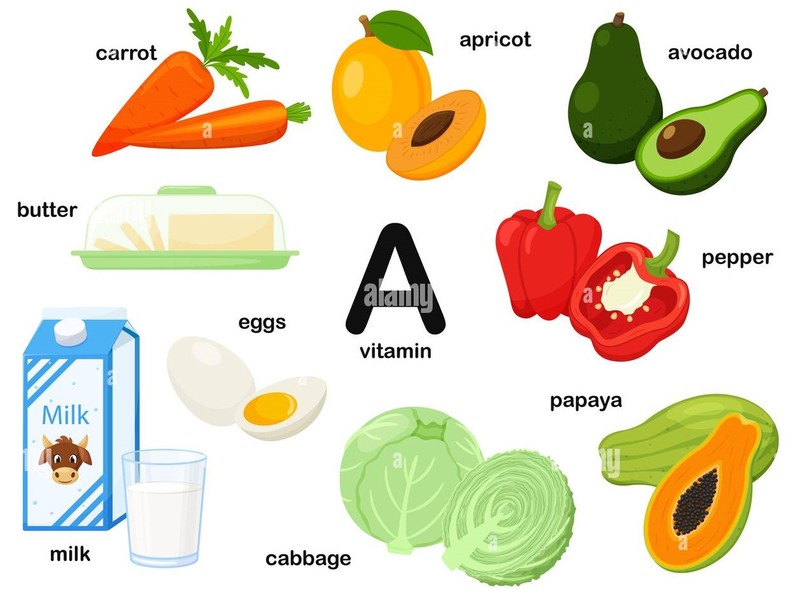 naturally in animal products including eggs and dairy. ‘Pro vitamin A’ or carotenoid (most common being beta-carotene), a nutrient that body converts into vitamin A, is found in all bright-coloured fruits and vegetables. The body can use the vitamin better from vegetables when cooked and eaten with healthy fat.9-12
naturally in animal products including eggs and dairy. ‘Pro vitamin A’ or carotenoid (most common being beta-carotene), a nutrient that body converts into vitamin A, is found in all bright-coloured fruits and vegetables. The body can use the vitamin better from vegetables when cooked and eaten with healthy fat.9-12
Symptoms of deficiency are fatigue, dry eyes (one of the first signs is the inability to produce tears), vision loss, inability to see in the dark leading to night blindness, dry, scaly, itchy, or rough bumpy skin, infertility, and delayed growth and development in children. Deficiency, mild or severe, can increase the risk of infection, especially in chest and throat.9-11
2.2 Vitamin D (the sunshine vitamin) / calciferol is both a nutrient we need and a hormone that our body makes to help absorb and retain the minerals critical for building bones, reduce cancer cell growth, inflammation, and infection; also, it supports the nervous, cardiovascular, 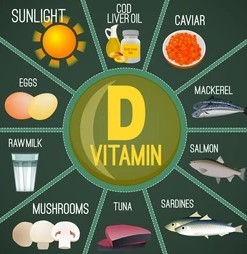 and endocrine systems. For details about its role, how to tap it from sunlight and other sources, and diseases due to its deficiency, refer to our Newsletter vol 3 #4 July-Aug 2012 and vol 5 #1 Jan-Feb 2014 and the links.13-19
and endocrine systems. For details about its role, how to tap it from sunlight and other sources, and diseases due to its deficiency, refer to our Newsletter vol 3 #4 July-Aug 2012 and vol 5 #1 Jan-Feb 2014 and the links.13-19
Indicators of deficiency are low calcium levels (hypocalcaemia), over-activated parathyroid glands (hyperparathyroidism), bone demineralisation and soft bones, deformity in bones and joints in children (rickets), muscle weakness, cramps, frequent falls, trouble walking, fatigue, and depression. So, be alert to symptoms.16
2.3 Vitamin E occurs naturally in fruits, nuts, seeds, and leafy green vegetables; in particular wheat germ oil (richest source), sunflower seeds, and almonds. It helps the body to use vitamin K. A strong  antioxidant, vitamin E can enhance cognitive and immune function, protect body cells and prevent clots in arteries, age-related vision loss, neurodegenerative diseases, and cancer. Studies suggest it can improve skin, hair, and liver health and relieve menstrual pain and cramps especially when combined with vitamin C and omega-3 fatty acid daily for 8 weeks. Vitamin E oil is considered healthy for application on skin, nails, and hair and can remove scars, dryness, and pimples.20-23
antioxidant, vitamin E can enhance cognitive and immune function, protect body cells and prevent clots in arteries, age-related vision loss, neurodegenerative diseases, and cancer. Studies suggest it can improve skin, hair, and liver health and relieve menstrual pain and cramps especially when combined with vitamin C and omega-3 fatty acid daily for 8 weeks. Vitamin E oil is considered healthy for application on skin, nails, and hair and can remove scars, dryness, and pimples.20-23
Signs of deficiency are damage to retina, peripheral neuropathy, loss of control in body movements, and decreased immunity.20-23
2.4 Vitamin K: Known as a busy nutrient, it makes some of the essential proteins needed for blood clotting, heart health, strong bones, and healing injuries. The more common K1 is found in green leafy and 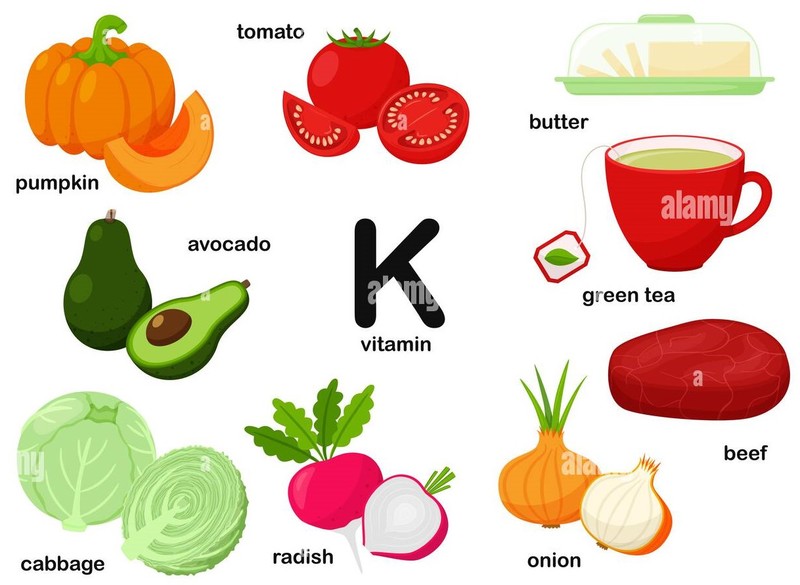 cruciferous vegetables, in fruits like blueberries and figs, and in smaller amounts in cereal grains and dairy products. The less common K2 is found in animal products and fermented foods and also produced by gut bacteria; stays longer in the body than K1, increasing benefits for the body. When one is deficient in vitamin D, K2 prevents calcification by directing calcium towards the bones; research shows taking K2 in diet along with vitamin D may reduce bone breakages, prevent plaque in arteries, and lower the risk of arthritis and dementia.24-28
cruciferous vegetables, in fruits like blueberries and figs, and in smaller amounts in cereal grains and dairy products. The less common K2 is found in animal products and fermented foods and also produced by gut bacteria; stays longer in the body than K1, increasing benefits for the body. When one is deficient in vitamin D, K2 prevents calcification by directing calcium towards the bones; research shows taking K2 in diet along with vitamin D may reduce bone breakages, prevent plaque in arteries, and lower the risk of arthritis and dementia.24-28
Signs of deficiency are small bruises under the fingernails, delay in blood clotting, uncontrolled bleeding, gum and nosebleeds, dark stools stained with blood, haemorrhage, osteopenia, or osteoporosis. Those on blood thinners should not take K supplement and also plan K intake from the diet as advised by their medical practitioner. In the case of infants, normally born with very small amounts of vitamin K in their bodies, a single intramuscular dose of vitamin K at birth is recommended to prevent bleeding.24-29
3. Water-soluble vitamins
3.1 Vitamin C (ascorbic acid): A powerful antioxidant, it strengthens the immune system and cellular health reducing the risk of serious diseases, lessens the severity of colds and flu, and keeps the eyes and skin healthy. It also facilitates better absorption of iron and helps heal wounds and cuts quickly. Foods high in vitamin C are Indian gooseberry (amla), cherries, strawberries, citrus, kiwi, guava, papaya, 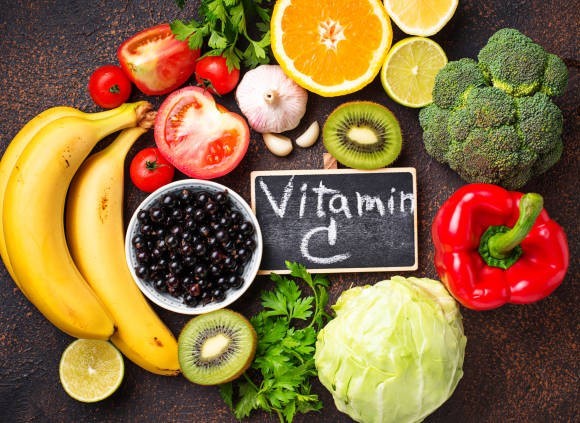 persimmons, green plums, yellow bell peppers, tomatoes, cruciferous vegetables, fresh parsley, and white potatoes.30-33
persimmons, green plums, yellow bell peppers, tomatoes, cruciferous vegetables, fresh parsley, and white potatoes.30-33
Warning signs of deficiency are skin spots caused by bleeding or bruising from broken blood vessels, swelling or bleeding of gums and eventual loss of teeth, hair loss, delayed healing of wounds, fatigue, and iron-deficiency anaemia. Scurvy is the hallmark disease of severe deficiency.30-33
Caution: People tend to take vitamin C supplements liberally. Though water soluble, excess may result in headache, bloating, diarrhoea, flushed skin, and cramps; may also lead to kidney stones and even failure; it can cause iron overload damaging heart, liver, and pancreas.30-33
3.2 B-vitamins: All eight B-vitamins contribute to health, reduce inflammation, support hormonal function, develop red blood cells, and ensure a healthy metabolism and digestive system. Though their roles and chemical properties are similar, each vitamin has its unique 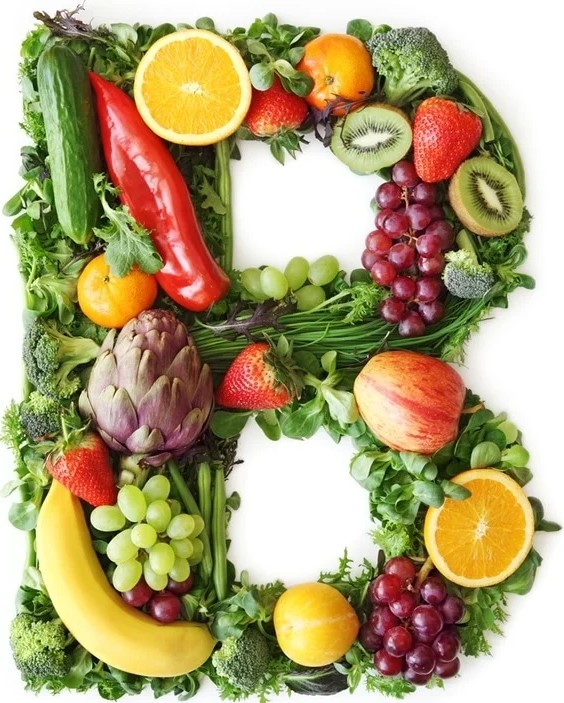 function to prevent fatigue, anaemia, mood disorders, and poor memory. A blend of several of these (B complex) would be best as they work synergistically.7,34,35
function to prevent fatigue, anaemia, mood disorders, and poor memory. A blend of several of these (B complex) would be best as they work synergistically.7,34,35
3.2.1 Vitamin B1: Found naturally in wholemeal cereal grains, most seeds, black beans, green peas, tamarind, and yogurt, it has a critical role in energy metabolism and nerve function. Tea and coffee block thiamine absorption. Severe deficiency may lead to beriberi impairing reflexes and motor function, causing muscle loss and diminished feeling in hands and feet (peripheral neuropathy), cognitive decline, paralysis, and heart failure.34,36-38
3.2.2 Vitamin B2: Best found in yogurt, milk, cheese, oats, quinoa, and almonds, a small quantity is present in apples, spinach, tomatoes, sunflower seeds, kidney beans, and in the gut bacteria. Essential for healthy skin and eyes, it reduces oxidative stress and helps in absorbing iron and other B-vitamins. Symptoms of deficiency include cracked lips, sore throat, skin rash, itchy red eyes, cataract in severe cases, and iron-deficiency anaemia. Long-term deficiency may cause migraines, brain and heart disorders, and some cancers. Excess can make urine bright yellow.4,6,39-41
3.2.3 Vitamin B3: It is found in grains like brown rice, nuts, seeds, legumes, and bananas; corn is naturally high in B3 but not absorbable unless it is cooked and ground. Though rare, severe deficiency may lead to a disease pellagra with dark scaly rash on skin areas exposed to sunlight, bright redness of the tongue, diarrhoea, depression, and dementia.42,43
3.2.4 Vitamin B5: It is present in cabbage, broccoli, white and sweet potatoes, avocados, brown rice, oats, sunflower seeds, and dairy products, and a small amount is made by gut bacteria. B5 helps the body to effectively utilise vitamin B2; also, used in cosmetics to heal various skin conditions including eczema, poison ivy, insect bites, diaper rash, and moisturise skin and hair. Symptoms of deficiency include fatigue, irritability, neuro problems, and upper respiratory infections. Severe deficiency is rare, but mild deficiency can cause severe health issues.44-46
3.2.5 Vitamin B6: It is naturally found in chickpeas (1 cup will meet 65% of our daily need) and other legumes, also in avocado, prunes, bananas, pistachios, dark leafy greens, green peas, carrots, and sweet potato. It is known to protect the immune system, brain, and nerves, prevent disease and relieve morning sickness in pregnant women. Its deficiency occurs when B12 and folic acid are low. Mild deficiency may have no symptoms, severe deficiency may show anaemia, depression, confusion, and low immunity. High dosages may cause peripheral neuropathy, loss of control of body movements, nausea, and sensitivity to light but these will subside when stopped.47-49
3.2.6 Vitamin B7: Good food sources are avocado, sweet potato, sunflower seeds, nuts, legumes, and mushrooms. Its deficiency can lead to hair loss, skin rash, and brittle nails. The benefits of supplements are based on inconclusive studies though glamorised and popular. Caution for those consuming raw eggs: it has a protein called avidin that prevents absorption of B7, but safe when cooked.50,51
3.2.7 Vitamin B9: It plays a key role in protein metabolism, production of genetic material, and healthy red blood cells, very critical during pregnancy and foetal development to prevent birth defects. The best foods are dark green leafy vegetables, raw or steamed briefly to retain the most folate; also beans, peanuts, sunflower seeds, whole grains, and tamarind. It is better absorbed (85%) from supplements in the form of folic acid than from food sources as folate (only 50%); higher amounts can mask B12 deficiency. Deficiency symptoms are anaemia, fatigue, irregular heartbeat, shortness of breath, hair loss, and mouth sores.52
3.2.8 Vitamin B12: It is vital for neurological function, DNA production, and red blood cell development. Learn about the benefits and sources of vitamin B12, how it is absorbed, symptoms of deficiency, diagnosis, and treatment from the article in our newsletter vol 4 #6, Nov-Dec 2013. Gut bacteria can make B12 but the process is hindered by gas, constipation, or indigestion.53-55
4. Prevent loss of vitamins
Deficiency happens when vitamin content in our diet is inadequate for long, either the diet is not wholesome, vitamins from food are not absorbed due to age or an underlying illness, or the lifestyle is unhealthy, especially alcoholism. Also, antibiotics can wipe out beneficial microbes and deplete nutrients like vitamin K and B-vitamins. Exposure to light destroys/deactivates vitamins A, D, E, K, B2, B7 (UV light); heat destroys vitamins A, C, B1, B9, B12; air destroys vitamins D, E, K, C, B9, B12.5,34,36,56,57
Consuming diverse foods containing flavonoids will enable us to utilize all the vitamins to the maximum. Flavonoids are a group of natural substances found in plant products - fruits (berries, cherries, citrus fruits) and green leafy vegetables, grains (black, purple, red colours), legumes, nuts, seeds, bark, roots, stems, flowers (dried parsley, oregano, chamomile, peppermint, red peppers) and some beverages like white, green, oolong, and black tea, dark chocolate, and have many health-promoting properties.58
Some nutrients in vegetables become absorbable only when cooked eg, whole carrots (with skin and unsliced), spinach, tomatoes, bell peppers; some should be consumed raw to get enough vitamin C. Vitamins B1, B2, B3, B6, and C seep into the cooking water; better to use the leftover liquid as a base for sauces.5,12
5. Tips to get the best out of vitamins
- Take care of your gut which makes some vitamins, and the liver where vitamins get stored.7,8,59
- Rely on a balanced diet of vegetables (both cooked and raw), fruits, whole grains, seeds and nuts, legumes, beans, lentils, and dairy products to get all the vitamins and to fix health problems. Avoid polished and refined carbs.6,36
- Cook food with just the essential amount of water and heat.5,12
- If you must, choose fortified foods with no added sugar, as they are usually quite processed.60
- Do not opt for supplements unless you have symptoms of deficiency or advised by your doctor. There is no fear of overconsumption of vitamins from food; excess of a supplement may cause toxicity. If on high doses, regular monitoring is important.6,34,61
- For maximum absorption, take the fat-soluble vitamins A, E, D, & K supplements after eating food containing fat eg, small amount of yogurt or food cooked with fat. Best time to take the water-soluble vitamins C and B12 is on an empty stomach before a meal, preferably morning, or 2 to 3 hrs after a meal. Also, take water and fat-soluble separately with a gap of 1-2 hours. Multivitamins with both kinds of vitamins may pose a challenge to the body; better to take them separately!62
Final word: Let food be thy medicine and let medicine be thy food…Hippocrates, the father of modern medicine.5,63
References and Links
- Divine Discourse of 21 Jan 1994 on “Food, the heart and the mind”: https://www.ssbpt.info/ssspeaks/vol27/sss27-03.pdf
- What are micros: https://www.who.int/health-topics/micronutrients#tab=tab_1
- https://www.nia.nih.gov/health/vitamins-and-supplements/vitamins-and-minerals-older-adults
- RDA for Micros: https://www.hsph.harvard.edu/nutritionsource/vitamins/
- Nature of Vitamins: https://www.bodybuilding.com/fun/vitamins.htm
- https://www.foodunfolded.com/article/vitamins-in-food-why-do-we-need-vitamins
- Vitamins profile: https://extension.colostate.edu/topic-areas/nutrition-food-safety-health/water-soluble-vitamins-b-complex-and-vitamin-c-9-312/
- Healthy fats: https://news.vibrionics.org/en/articles/419
- Vit A deficiency: https://my.clevelandclinic.org/health/diseases/23107-vitamin-a-deficiency
- https://www.healthline.com/nutrition/vitamin-a-deficiency-symptoms
- https://patient.info/healthy-living/vitamin-a-deficiency-leaflet
- Veg best cooked: https://theconversation.com/nine-vegetables-that-are-healthier-for-you-when-cooked-182723
- Vitamin D: https://www.hsph.harvard.edu/nutritionsource/vitamin-d/#
- Enhanced role of vitamin D: https://ncbi.nlm.nih.gov/pmc/articles/PMC4399494/
- https://consultqd.clevelandclinic.org/understanding-the-endocrine-impact-of-vitamin-d-calcium-deficiency-in-the-elderly/#
- D deficiency: https://my.clevelandclinic.org/health/diseases/15050-vitamin-d-vitamin-d-deficiency
- Source sunshine: https://news.vibrionics.org/en/articles/133
- https://news.vibrionics.org/en/articles/167
- https://www.goodreads.com/quotes/tag/vitamins
- Vitamin E: https://www.hsph.harvard.edu/nutritionsource/vitamin-e/
- https://www.healthline.com/health/all-about-vitamin-e#3.-May-benefit-those-with-nonalcoholic-fatty-liver-disease-(NAFLD)
- https://ufhealth.org/conditions-and-treatments/vitamin-e
- https://www.lybrate.com/question/1095904873/hey-i-bought-evion-400-capsule-can-i-have-it-what-are-the-uses-of-it-in-skin-and-hair
- Vitamin K: https://health.clevelandclinic.org/vitamin-k
- https://health.clevelandclinic.org/vitamin-k2
- https://www.hsph.harvard.edu/nutritionsource/vitamin-k/#
- https://www.healthline.com/health/vitamin-k
- https://www.usatoday.com/story/life/health-wellness/2023/03/27/what-vitamin-k-benefits-body-who-needs-it-k-2-explained/11548498002/
- Vitamin K at birth: https://www.cdc.gov/breastfeeding/breastfeeding-special-circumstances/diet-and-micronutrients/vitamin-k.html
- Vitamin C: https://health.clevelandclinic.org/vitamin-c
- https://www.hsph.harvard.edu/nutritionsource/vitamin-c/
- https://www.ncbi.nlm.nih.gov/pmc/articles/PMC4648887/
- https://www.healthline.com/nutrition/vitamin-c-foods
- Vitamin B: https://www.betterhealth.vic.gov.au/health/healthyliving/vitamin-b
- https://draxe.com/nutrition/vitamin-b/
- Vitamin B1: https://www.hsph.harvard.edu/nutritionsource/vitamin-b1/
- https://tools.myfooddata.com/nutrient-ranking-tool/thiamin-b1/nuts-and-seeds/highest
- https://www.healthline.com/nutrition/thiamine-deficiency-symptoms
- Vitamin B2: https://ods.od.nih.gov/factsheets/Riboflavin-HealthProfessional/
- https://draxe.com/nutrition/vitamin-b2/
- https://www.hsph.harvard.edu/nutritionsource/riboflavin-vitamin-b2/
- Vitamin B3: https://www.hsph.harvard.edu/nutritionsource/niacin-vitamin-b3/
- https://my.clevelandclinic.org/health/diseases/23905-pellagra
- Vitamin B5: https://www.hsph.harvard.edu/nutritionsource/pantothenic-acid-vitamin-b5/
- https://www.healthline.com/health/vitamin-watch-what-does-b5-do#food-sources
- https://draxe.com/nutrition/top-10-vitamin-b5-foods-pantothenic-acid/
- Vitamin B6: https://www.hsph.harvard.edu/nutritionsource/vitamin-b6/
- https://health.clevelandclinic.org/vitamin-b6
- https://ods.od.nih.gov/factsheets/VitaminB6-HealthProfessional/
- Vitamin B7: https://www.hsph.harvard.edu/nutritionsource/biotin-vitamin-b7/
- https://www.medicinenet.com/11_foods_that_have_the_highest_biotin/article.htm
- Vitamin B9: https://medicalnewstoday.com/articles/287677
- Vitamin B12: https://news.vibrionics.org/en/articles/164
- https://my.clevelandclinic.org/health/diseases/22831-vitamin-b12-deficiency
- Vitamin B12 stored: https://www.merckmanuals.com/home/disorders-of-nutrition/vitamins/vitamin-b12-deficiency#
- Nutritional deficiency causes: https://www.ncbi.nlm.nih.gov/pmc/articles/PMC9710417/#
- Antibiotics affect gut bacteria: https://my.clevelandclinic.org/health/body/25201-gut-microbiome
- Flavonoids: https://www.healthline.com/health/what-are-flavonoids-everything-you-need-to-know#sources
- Role of gut bacteria: https://www.ncbi.nlm.nih.gov/pmc/articles/PMC3144392/#
- Choose fortified foods: https://www.healthline.com/health/food-nutrition/fortified-and-enriched-foods#Bottom-line
- Supplements: https://www.pennmedicine.org/updates/blogs/health-and-wellness/2020/february/the-truth-about-supplements#
- Best time for vitamins: https://health.clevelandclinic.org/the-best-time-to-take-vitamins
- Food as medicine: https://www.ncbi.nlm.nih.gov/pmc/articles/PMC318470/
2. Workshops & Seminar
1. AVP workshop: virtual 1-18 Nov followed by face-to-face at Puttaparthi 25-27 Nov 2023
Five participants from India and one from Guatemala qualified as AVPs and took oath. Several practitioners including those aspiring to be vibrionics teachers or becoming part of the admin team also participated  as observers during the workshop. During the intense three days of practical sessions, the participants not only revised what they had learnt during the preceding six months of online study but also gained practical experience during actual interaction with patients and this, they all appreciated. In his valedictory address, Dr J K Aggarwal emphasized the immense potential of vibrionics. He encouraged the newly qualified practitioners to view their AVP qualification as a stepping stone in their Vibrionics journey since there are advanced courses available. He warned against giving talks on vibrionics without greater knowledge and experience; several practitioners have made this mistake previously. He further advised them to stay grounded, regardless of the results, remaining humble when patients praise them and report successful recoveries (this can fuel the ego!), and not to be discouraged if the results are not as expected, since cure is in the hands of the Lord. Altogether the practical workshop ignited a sense of service and dedication among the new AVPs, who pledged to do their best.
as observers during the workshop. During the intense three days of practical sessions, the participants not only revised what they had learnt during the preceding six months of online study but also gained practical experience during actual interaction with patients and this, they all appreciated. In his valedictory address, Dr J K Aggarwal emphasized the immense potential of vibrionics. He encouraged the newly qualified practitioners to view their AVP qualification as a stepping stone in their Vibrionics journey since there are advanced courses available. He warned against giving talks on vibrionics without greater knowledge and experience; several practitioners have made this mistake previously. He further advised them to stay grounded, regardless of the results, remaining humble when patients praise them and report successful recoveries (this can fuel the ego!), and not to be discouraged if the results are not as expected, since cure is in the hands of the Lord. Altogether the practical workshop ignited a sense of service and dedication among the new AVPs, who pledged to do their best.
2. AVP & refresher workshop: Perigueux, France 9-13 Nov 2023
The French coordinator 01620 organized a refresher cum AVP workshop for three participants. One of these is a new candidate and another who trained two years ago and felt the need for a refresher. The third had taken up vibrionics in 2004 but due to family commitments, her vibrionics activity had reduced to minimal. Now she was enthusiastic about  resuming her seva. She, along with the coordinator, had been making preparations for this workshop through an eCourse over several months. She looks forward to using the 108CC Box in addition to the SRHVP she already had. The three participants successfully passed their exams and took an oath. They were delighted to have an interaction with Dr Aggarwal over Zoom and he was happy to clarify their doubts which were mainly to do with the ideal gap between two remedies including oral, topical or other modalities. Then the practitioners were ready to confidently march on with their seva.
resuming her seva. She, along with the coordinator, had been making preparations for this workshop through an eCourse over several months. She looks forward to using the 108CC Box in addition to the SRHVP she already had. The three participants successfully passed their exams and took an oath. They were delighted to have an interaction with Dr Aggarwal over Zoom and he was happy to clarify their doubts which were mainly to do with the ideal gap between two remedies including oral, topical or other modalities. Then the practitioners were ready to confidently march on with their seva.
3. Practitioners’ meet at Sai International Centre, Delhi on 10 December 2023
Practitioners from Delhi NCR had a fruitful interactive session with Dr and Mrs Aggarwal at a half-day seminar organised by SVIRT Governor11964. It was very encouraging that despite the short notice, twenty practitioners attended. There was much emphasis on the importance of connecting with Swami while dispensing and that of selfless service without an iota of ego or expectation! Dr Aggarwal explored and dwelled deep into explaining the true meaning of liberation & answered participants' queries by giving practical examples. Practitioners on their part shared many successful and even miraculous cases, illustrating the amazing efficacy of vibrionics. They were encouraged to send in such cases for the benefit of vibrionics community at large. The State President of Delhi NCR, illuminous of SSSIHL, showed great interest in vibrionics and addressed the gathering; this was very encouraging for them.

3. Camps & Clinics
Camps held under the aegis of SVIRT in November 2023 to celebrate Swami’s 98th Birthday.
In the holy month of November, 33 practitioners from 12 states of India namely. AP, Delhi, Gujarat, Haryana, Karnataka, Kerala, Maharashtra, Rajasthan, Telangana, UP, Uttarakhand and West Bengal held 30 camps of 1 to 3 days duration and treated 1634 patients and distributed 1668 IB bottles. Venues included schools, remote villages, public and religious places and local Sai centres. Of special mention is the 15th annual camp, held from 21 to 23 Nov at Puttaparthi railway station, organised by Practitioner 01228, supported by three others. The continuous stream of patients kept the four practitioners on their toes and this enthusiastic team attended to 913 patients. Like previous years many patients from neighbouring villages took advantage of this opportunity. A group of students from nearby Penukonda College invited our team to conduct a medical camp for their 300 students after their exams and winter break, with the prospect of this becoming a regular feature.



4. Eco-friendly drive
Prematharu tree plantation initiative gains momentum!
In Andhra Pradesh, an afforestation program using the Japanese Miyawaki technique has been taken up by the Sai organization in Vizag, in association with the Afforestation Department of Vizag Steel Plant. On 27 Sep 2023, 3200 saplings were planted. Practitioner 11634…India, being part of this mega event, is giving the following remedy for healthy growth:
CC1.2 Plant tonic + NM67 Calcium + SM1 Removal of Entities + SM5 Peace & Love Alignment
The plants are being monitored with the help of the staff of the Afforestation Department, who were explained the procedure for making large quantities of the remedy.
At another site, Donkad colony consisting of 3 acres of land where 14,500 trees of native species are being planted, 17 practitioners from Vizag under the leadership of Senior Practitioner 11567…India, have joined forces with various spiritual organisations for this task.
In Delhi-NCR, Practitioner 11437 took the initiative to spray Plant tonic on 1600 newly planted fruit, flowering and other trees at the bird sanctuary City Forest in Noida.

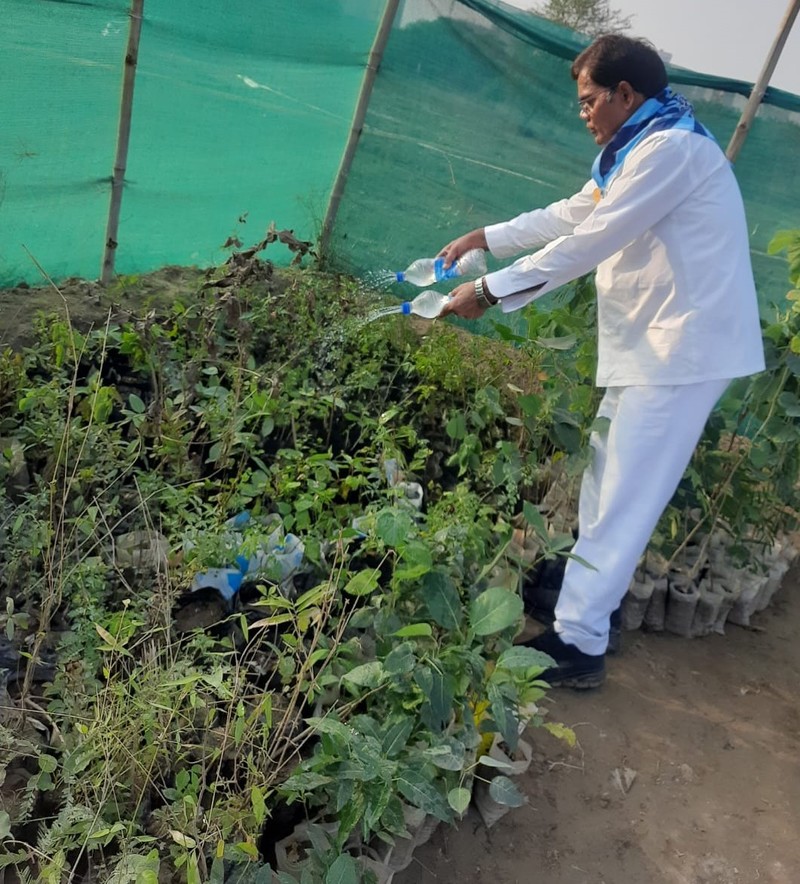
5. Anecdote
In the right place at the right time 11570...India
On 8 March 2023, while Holi was being celebrated in her neighborhood, the practitioner heard some loud cries for help. She discovered that a teenager had hit with his water gun, a large beehive housed in a nearby tree. The disturbed bees attacked an innocent bystander. Ruthlessly they started stinging the 45-year-old helpless man, all over his head, neck, and arms. The practitioner rushed to her house, made CC21.4 Stings & Bites + CC21.11 Wounds & Abrasions in water and sprayed it all over the stings. When she met him the same evening, he informed her that, he returned home and slept for a few hours. When he woke up, he could not believe that there was no pain and hardly any swelling. The next morning, he was completely healed, cheerful and went to work as usual. The practitioner is grateful to Swami for putting her in the right place at the right time!
6. In Memoriam
We mourn the loss in September 2023 of our 59-year-old Katharina Reiter 02713…Austria, a sterling sevite and devoted translator into German of the vibrionics newsletter. Her husband writes "Our dearly beloved Lord Bhagwan Sri Sathya Sai Baba has accompanied and guided us every moment on this stage of our spiritual journey. Katharina left her mortal body... in absolute peace with herself." It was her desire that all who wish to remember her do so in the silence of their heart, joining her there eternally in the Lord's precious darshan. In the stormy waves of this loss, her loving husband remembers Baba's words: "Where can she go? Nowhere. She is now here. Eternally One."
We have lost on 22 Oct, yet another Sai jewel, Rozalija Marolt 02243…Slovenia 77-year-old Rozalija was a long-time patient herself, battling classic lymphocyte leukaemia for years, but that didn't stop her from serving others with vibrionics and submitting her monthly reports almost up to her last day. She was a regular participant at her local Sai Centre, ever calm and never complaining, another sterling practitioner devotee now resting safely in Sai's sweetest Love.
